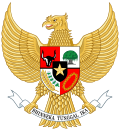| Southeast Borneo Federation Federasi Kalimantan Tenggara | |||||||||
|---|---|---|---|---|---|---|---|---|---|
| State-level autonomous region of Indonesia | |||||||||
| 1947–1950 (sovereign state until 1949) | |||||||||
 Southeast Borneo Federation in the United States of Indonesia | |||||||||
| Historical era | Cold War | ||||||||
• Established | January 1947 | ||||||||
• Disestablished | 18 April 1950 (sovereign state until 1949) | ||||||||
| |||||||||
Southeast Borneo Federation (Indonesian : Federasi Kalimantan Tenggara) was an autonomous area formed in the southeastern part of Indonesian island of Borneo by the Netherlands in 1948 as part of an attempt to re-establish the colony of the Dutch East Indies during the Indonesian National Revolution. Southeast Borneo became a constituent part of the United States of Indonesia in 1949. The Federation was dissolved on 18 April 1950 and combined with Great Dayak and Bandjar to form South Kalimantan Province.
